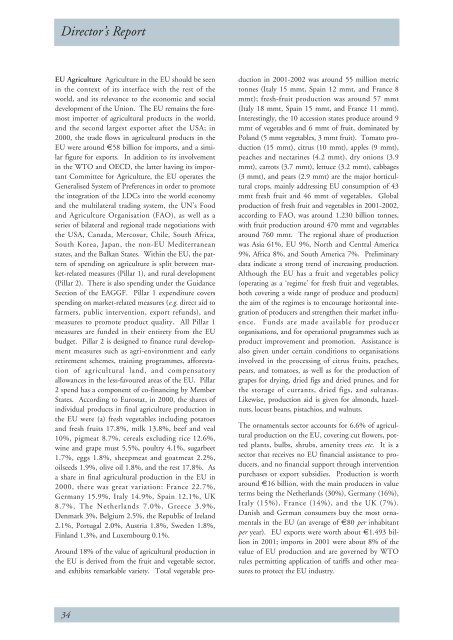PDF file: Annual Report 2002/2003 - Scottish Crop Research Institute
PDF file: Annual Report 2002/2003 - Scottish Crop Research Institute
PDF file: Annual Report 2002/2003 - Scottish Crop Research Institute
You also want an ePaper? Increase the reach of your titles
YUMPU automatically turns print PDFs into web optimized ePapers that Google loves.
Director’s <strong>Report</strong><br />
EU Agriculture Agriculture in the EU should be seen<br />
in the context of its interface with the rest of the<br />
world, and its relevance to the economic and social<br />
development of the Union. The EU remains the foremost<br />
importer of agricultural products in the world,<br />
and the second largest exporter after the USA; in<br />
2000, the trade flows in agricultural products in the<br />
EU were around €58 billion for imports, and a similar<br />
figure for exports. In addition to its involvement<br />
in the WTO and OECD, the latter having its important<br />
Committee for Agriculture, the EU operates the<br />
Generalised System of Preferences in order to promote<br />
the integration of the LDCs into the world economy<br />
and the multilateral trading system, the UN’s Food<br />
and Agriculture Organisation (FAO), as well as a<br />
series of bilateral and regional trade negotiations with<br />
the USA, Canada, Mercosur, Chile, South Africa,<br />
South Korea, Japan, the non-EU Mediterranean<br />
states, and the Balkan States. Within the EU, the pattern<br />
of spending on agriculture is split between market-related<br />
measures (Pillar 1), and rural development<br />
(Pillar 2). There is also spending under the Guidance<br />
Section of the EAGGF. Pillar 1 expenditure covers<br />
spending on market-related measures (e.g. direct aid to<br />
farmers, public intervention, export refunds), and<br />
measures to promote product quality. All Pillar 1<br />
measures are funded in their entirety from the EU<br />
budget. Pillar 2 is designed to finance rural development<br />
measures such as agri-environment and early<br />
retirement schemes, training programmes, afforestation<br />
of agricultural land, and compensatory<br />
allowances in the less-favoured areas of the EU. Pillar<br />
2 spend has a component of co-financing by Member<br />
States. According to Eurostat, in 2000, the shares of<br />
individual products in final agriculture production in<br />
the EU were (a) fresh vegetables including potatoes<br />
and fresh fruits 17.8%, milk 13.8%, beef and veal<br />
10%, pigmeat 8.7%, cereals excluding rice 12.6%,<br />
wine and grape must 5.5%, poultry 4.1%, sugarbeet<br />
1.7%, eggs 1.8%, sheepmeat and goatmeat 2.2%,<br />
oilseeds 1.9%, olive oil 1.8%, and the rest 17.8%. As<br />
a share in final agricultural production in the EU in<br />
2000, there was great variation: France 22.7%,<br />
Germany 15.9%, Italy 14.9%, Spain 12.1%, UK<br />
8.7%, The Netherlands 7.0%, Greece 3.9%,<br />
Denmark 3%, Belgium 2.5%, the Republic of Ireland<br />
2.1%, Portugal 2.0%, Austria 1.8%, Sweden 1.8%,<br />
Finland 1.3%, and Luxembourg 0.1%.<br />
Around 18% of the value of agricultural production in<br />
the EU is derived from the fruit and vegetable sector,<br />
and exhibits remarkable variety. Total vegetable production<br />
in 2001-<strong>2002</strong> was around 55 million metric<br />
tonnes (Italy 15 mmt, Spain 12 mmt, and France 8<br />
mmt); fresh-fruit production was around 57 mmt<br />
(Italy 18 mmt, Spain 15 mmt, and France 11 mmt).<br />
Interestingly, the 10 accession states produce around 9<br />
mmt of vegetables and 6 mmt of fruit, dominated by<br />
Poland (5 mmt vegetables, 3 mmt fruit). Tomato production<br />
(15 mmt), citrus (10 mmt), apples (9 mmt),<br />
peaches and nectarines (4.2 mmt), dry onions (3.9<br />
mmt), carrots (3.7 mmt), lettuce (3.2 mmt), cabbages<br />
(3 mmt), and pears (2.9 mmt) are the major horticultural<br />
crops, mainly addressing EU consumption of 43<br />
mmt fresh fruit and 46 mmt of vegetables. Global<br />
production of fresh fruit and vegetables in 2001-<strong>2002</strong>,<br />
according to FAO, was around 1.230 billion tonnes,<br />
with fruit production around 470 mmt and vegetables<br />
around 760 mmt. The regional share of production<br />
was Asia 61%, EU 9%, North and Central America<br />
9%, Africa 8%, and South America 7%. Preliminary<br />
data indicate a strong trend of increasing production.<br />
Although the EU has a fruit and vegetables policy<br />
(operating as a ‘regime’ for fresh fruit and vegetables,<br />
both covering a wide range of produce and products)<br />
the aim of the regimes is to encourage horizontal integration<br />
of producers and strengthen their market influence.<br />
Funds are made available for producer<br />
organisations, and for operational programmes such as<br />
product improvement and promotion. Assistance is<br />
also given under certain conditions to organisations<br />
involved in the processing of citrus fruits, peaches,<br />
pears, and tomatoes, as well as for the production of<br />
grapes for drying, dried figs and dried prunes, and for<br />
the storage of currants, dried figs, and sultanas.<br />
Likewise, production aid is given for almonds, hazelnuts,<br />
locust beans, pistachios, and walnuts.<br />
The ornamentals sector accounts for 6.6% of agricultural<br />
production on the EU, covering cut flowers, potted<br />
plants, bulbs, shrubs, amenity trees etc. It is a<br />
sector that receives no EU financial assistance to producers,<br />
and no financial support through intervention<br />
purchases or export subsidies. Production is worth<br />
around €16 billion, with the main producers in value<br />
terms being the Netherlands (30%), Germany (16%),<br />
Italy (15%), France (14%), and the UK (7%).<br />
Danish and German consumers buy the most ornamentals<br />
in the EU (an average of €80 per inhabitant<br />
per year). EU exports were worth about €1.493 billion<br />
in 2001; imports in 2001 were about 8% of the<br />
value of EU production and are governed by WTO<br />
rules permitting application of tariffs and other measures<br />
to protect the EU industry.<br />
34
















